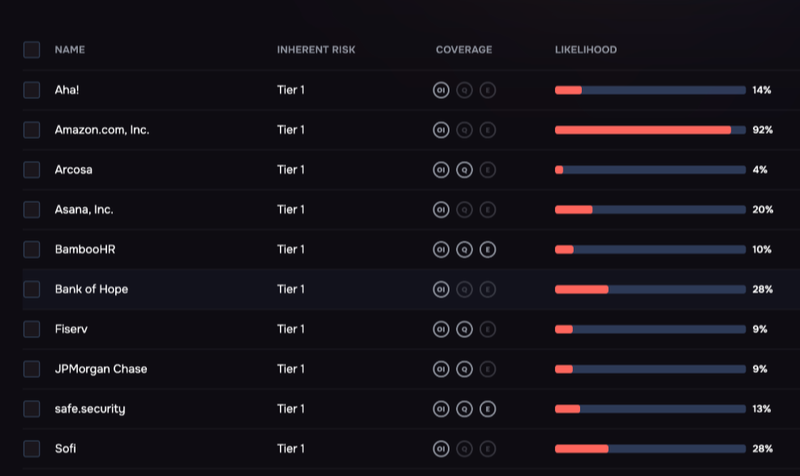Every new vendor, partner, or fourth party you connect with is another potential doorway for attackers

Tiering vendors on the SAFE One risk management platform
Every new vendor, partner, or fourth party you connect with is another potential doorway for attackers. And the numbers are getting scarier: according to the 2025 Verizon DBIR, third-party involvement in breaches doubled year-over-year—from 15% to 30%.
When a single weak link can disrupt your entire business—like the attack on Clorox through its help-desk provider—you can’t afford to treat all vendors the same. Tiering your vendors by real cyber risk isn’t optional anymore; it’s the difference between chaos and control.
In this guide, we’ll cover:
- Need for third-party tiering and prioritization
- How to get started with vendor tiers
- How to define your tiers
- What should you consider when defining your tiers?
- Smart tips for handling vendor risk management
Author Jacqueline Lebo is a Strategic Risk Advisor at SAFE
Introduction
Large companies ride herd on thousands of third-party vendors. But even smaller firms are surrounded by a constellation of dotted line suppliers when you take into account fourth parties, the vendors’ vendors.
The impacts can be highly material. Giant consumer goods company Clorox suffered widespread business interruption in 2023 after the Scattered Spider threat group social-engineered Clorox’s help-desk provider Cognizant, Clorox claimed in a recent lawsuit.
That’s why prioritization and vendor tiering are your lifelines. Instead of scrambling to keep tabs on everyone, you’ll know exactly where to shine the spotlight, saving time and sidestepping trouble.
This blog post breaks it down: why tiering matters, how to do it based on risk and how the right approach transforms your TPRM from chaos to control.
Get Started with Vendor Tiering and Prioritization
Effective Third-Party Risk Management (TPRM) isn’t just about checklists; it’s about understanding the quantifiable, critical risk that any vendor poses to your organization.
The two over-arching steps to kick off your tiering effort are:
Step 1: Inventory every third-party vendor to the best extent possible. Don’t forget the folks different departments work with quietly in the background—every contract counts.
Step 2: Inventory the critical assets or functions that a third party might access or impact (at SAFE, we call these “business resources”).
Consider: What kind of data do vendors see? Do they touch critical systems? Would a slip-up shut down your operations or just mean no lunch delivered for a day?
Business Resources: Nine Categories of Critical Assets or Functions
- Customer Data
- Network
- Revenue
- Sensitive Personal Data
- Business Data
- Integration
- None
- Other
- Unknown.
What Are the Key Risk-Based Tiers for Vendors?
We can now define risk-based tiers, from Tier 1 (handle with care), to Tier 4 (nothing mission critical) based on this assessment of access to assets and functions.
Note: If you are also running FAIR quantitative risk analysis to identify the most risky scenarios for your organization, you’ll find that approach aligns with this risk-based approach to vendor tiering.
| Risk Tier | Vendor Access | Vendor Services |
| 1 Critical | Highly sensitive data, critical network infrastructure, core revenue-generating systems. | CSPs, MSSPs, banking, payroll |
| 2 High | Important, but perhaps not immediately catastrophic, data or systems. | Marketing operations, customer support, HR |
| 3 Moderate | Limited or indirect access to sensitive data or critical systems. | Productivity suites, physical security, facilities management |
| 4 Low | No direct access to critical systems or sensitive data. | Catering, landscaping, one-off software purchase |
Tier 1: Critical Risk (High Impact Potential)
Characteristics: Vendors with direct access to highly sensitive data, critical network infrastructure, or core revenue-generating systems. Their compromise would result in severe financial, operational, reputational, or regulatory damage.
Examples: CSPs, MSSPs, payroll, banking, enterprise resource planning (ERP), electronic health records (EHR) providers
Business Resources: Primarily Sensitive Personal Data, Network, Revenue, and potentially extensive Customer Data (especially if highly sensitive PII/PHI is involved) or critical Integration points that are system-of-record impacting.
Best Practice: Require the most rigorous due diligence, continuous monitoring, and frequent reassessments.
Tier 2: High Risk (Significant Impact Potential)
Characteristics: Vendors with access to important, but perhaps not immediately catastrophic, data or systems. Their compromise could cause significant operational disruption, data exposure, or moderate financial/reputational harm.
Business Resources: Customer Data (non-sensitive PII, high volume), Business Data (critical operational, non-PII), and significant Integration points that support core business functions.
Examples: platforms for marketing operations, CRM, customer support, HR, email marketing, business intelligence (BI)
Best Practice: Require comprehensive due diligence, regular monitoring, and periodic reassessments.
Tier 3: Moderate Risk (Limited Impact Potential)
Characteristics: Vendors providing supporting services with limited or indirect access to sensitive data or critical systems. Their compromise would likely result in minor disruption or limited data exposure.
Examples: cloud-based productivity suites, physical security vendors, travel management companies, meetings tools, office supply vendors, facilities management vendors.
Business Resources: Limited Business Data, non-critical Integration, or general services falling under “Other” with defined, limited data access.
Best Practice: Require standard due diligence and routine monitoring.
Tier 4: Low Risk (Minimal Impact Potential)
Characteristics: Vendors with no direct access to critical systems or sensitive data. These are often highly commoditized services with minimal impact on your operations.
Examples: Catering, landscaping, a one-time purchase of off-the-shelf software.
Business Resources: Primarily None.
What Should You Consider When Defining Your Tiers?
If a third party has access to multiple business resources, always assign them the highest applicable tier. The risk is cumulative, and the highest potential impact dictates the tier.
Vendors with access to “None” of your defined business resources should generally be assigned to Tier 4 (Lowest Risk).
A vendor whose access to business resources is “Unknown” represents an unquantified risk and should initially be assigned to Tier 1 (Critical Risk).

Onboarding vendors to the SAFE One platform
6 Smart Tips on Handling Vendors
Vendor risk assessment begins with onboarding. Best practices include taking in a questionnaire filled out by the vendor documenting controls and security practices – but verified with both outside-in and inside-out scans of the actual control environment.
TPRM is not one and done. Ideally, you should continuously identify, assess and mitigate third-party risks in realtime, get real-time alerts for vendor control gaps, as well as vendor exposure assessment for new breach notifications.
Don’t pass over small vendors or fourth parties. Evaluating risk based on size of contract is a mistake – a small vendor might have deep and risky system access. Fourth parties, your vendor’s vendors, can be traced through DNS research accomplished with AI so you can map your supply chain.
Automate tiering. In fact, automate everything TPRM. Your TPRM system should assess vendor risk posture, adjust tiers on the fly, and auto-generate email notifications. .
Keep lines of communication open. Clear communication is everything—especially with higher-tier vendors. Involve them in making continuous monitoring work, establish contracts and SLAs with clear performance benchmarks so everyone is on the same page from the start.
Super tip: AI makes it all happen – from onboarding to risk assessment to continuous monitoring – AI driven tools and processes scale and enable TPRM at best-practices level.
Wrap-Up: Tiering Is Your TPRM Superpower
Tiering your vendors isn’t extra—it’s essential. When you break your vendor ecosystem down to manageable proportions, you get focus, efficiency, and peace of mind. Risks shrink, compliance gets easier, and the board starts nodding their heads instead of raising their eyebrows.
At Safe Security, we’ve mastered 100% autonomous AI-driven third party risk management. Watch a video to see SAFE TPRM in action then schedule your own demo.



